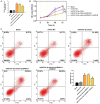LncRNA HAGLR absorbing miR-214-3p promotes BMP2 expression and improves tibial fractures
- PMID: 34786043
- PMCID: PMC8581928
LncRNA HAGLR absorbing miR-214-3p promotes BMP2 expression and improves tibial fractures
Abstract
Objective: To determine whether long-chain non-coding RNA (lncRNA) HAGLR can regulate BMP2 by absorbing microRNA-214-3p (miR-214-3p), and to explore its role and mechanism in tibial fracture (TF) healing.
Methods: The HAGLR, miR-214-3p, and BMP2 expression levels in TF and in adjacent normal tissues were measured using quantitative real-time polymerase chain reaction (qRT-PCR). MC3T3-E1 osteoblasts were used to construct the in vitro model. HAGLR was localized subcellularly through RNA-fluorescence in situ hybridization (FISH). A dual-luciferase report experiment confirmed that miR-214-3p has a targeted relationship with HAGLR and BMP2. It was then divided into a HAGLR over-expression group, an miR-214-3p mimic group, a HAGLR+miR-214-3p mimic group, an sh-HAGLR group, a BMP over-expression group, an sh-HAGLR+over-expression BMP2 group, and a negative control group. The proliferation and apoptosis of the MC3T3-E1 osteoblasts were examined using MTT assays and flow cytometry. A TF model was established in male C57BL/6J mice. The serum alkaline phosphatase (ALP) and osteoprotegerin (OPG) levels in the sham group, the TF group, and the TF group that were injected with HAGLR were compared using ELISA. Hematoxylin-eosin (HE) staining was used to confirm the fracture healing in the mouse model.
Results: Compared with the adjacent normal tissues in the TF patients, the HAGLR and BMP2 expressions decreased but the miR-214-3p expressions increased in the TF tissues (P<0.05). HAGLR, an endogenous sponge, absorbed the miR-214-3p, and the BMP2 expression was directly regulated by miR-214-3p. HAGLR increased the proliferative activity of the osteoblasts and decreased the apoptosis rate. The over-expression of miR-214-3p partly reversed the effect of HAGLR on the cells, decreased the proliferative activity, and increased the apoptosis rate (all P<0.05). The sh-HAGLR decreased the proliferative activity and increased the apoptosis rate. But after the over-expression of BMP2, the proliferative activity of the cells was higher, and the apoptosis rate was lower than it was in the sh-HAGLR group (all P<0.05). The over-expression of HAGLR can up-regulate the ALP and OPG levels in mouse models (P<0.05).
Conclusion: lncRNA HAGLR can regulate BMP2 to play a protective role in TF by absorbing miR-214-3p, and it is related to promoting the osteoblast proliferation, inhibiting apoptosis, and up-regulating the serum ALP and OPG levels to accelerate bone healing.
Keywords: Tibial fractures; apoptosis; lncRNA HAGLR; osteoblasts; proliferation.
AJTR Copyright © 2021.
Conflict of interest statement
None.
Figures








Similar articles
-
Long non-coding TRPM2-AS regulates fracture healing by targeting miR-545-3p/Bmp2.J Orthop Surg Res. 2024 Aug 8;19(1):466. doi: 10.1186/s13018-024-04969-5. J Orthop Surg Res. 2024. PMID: 39118176 Free PMC article.
-
LncRNA HAGLR accelerates femoral neck fracture healing through negatively regulating miRNA-19a-3p.Eur Rev Med Pharmacol Sci. 2020 Apr;24(8):4080-4087. doi: 10.26355/eurrev_202004_20984. Eur Rev Med Pharmacol Sci. 2020. PMID: 32373944
-
LncRNA-HAGLR motivates triple negative breast cancer progression by regulation of WNT2 via sponging miR-335-3p.Aging (Albany NY). 2021 Aug 10;13(15):19306-19316. doi: 10.18632/aging.203272. Epub 2021 Aug 10. Aging (Albany NY). 2021. PMID: 34375306 Free PMC article.
-
Downregulation of lncRNA XIST promotes proliferation and differentiation, limits apoptosis of osteoblasts through regulating miR-203-3p/ZFPM2 axis.Connect Tissue Res. 2021 Jul;62(4):381-392. doi: 10.1080/03008207.2020.1752200. Epub 2020 Apr 24. Connect Tissue Res. 2021. PMID: 32326773
-
Zoledronic Acid Accelerates Bone Healing in Carpal Navicular Fracture via Silencing Long Non-coding RNA Growth Arrest Specificity 5 to Modulate MicroRNA-29a-3p Expression.Mol Biotechnol. 2024 Nov;66(11):3238-3251. doi: 10.1007/s12033-023-00931-8. Epub 2023 Oct 20. Mol Biotechnol. 2024. PMID: 37861953
Cited by
-
The novel circRNA circ_0045881 inhibits cell proliferation and invasion by targeting mir-214-3p in triple-negative breast cancer.BMC Cancer. 2024 Mar 1;24(1):278. doi: 10.1186/s12885-024-12007-0. BMC Cancer. 2024. PMID: 38429642 Free PMC article.
-
Fluid Shear Stress Promotes Osteoblast Proliferation and Suppresses Mitochondrial-Mediated Osteoblast Apoptosis Through the miR-214-3p-ATF4 Signaling Axis.Physiol Res. 2022 Aug 31;71(4):527-538. doi: 10.33549/physiolres.934917. Epub 2022 Jun 30. Physiol Res. 2022. PMID: 35770472 Free PMC article.
-
Serum miR-519d-3p and BMP2: potential early diagnostic markers and their mechanism in delayed fracture healing.J Orthop Surg Res. 2025 Mar 21;20(1):302. doi: 10.1186/s13018-025-05695-2. J Orthop Surg Res. 2025. PMID: 40114247 Free PMC article.
-
Long non-coding TRPM2-AS regulates fracture healing by targeting miR-545-3p/Bmp2.J Orthop Surg Res. 2024 Aug 8;19(1):466. doi: 10.1186/s13018-024-04969-5. J Orthop Surg Res. 2024. PMID: 39118176 Free PMC article.
-
LncRNA A1BG-AS1 regulates the progress of diabetic foot ulcers via sponging miR-214-3p.Endocr J. 2025 Mar 3;72(3):295-306. doi: 10.1507/endocrj.EJ24-0440. Epub 2025 Jan 7. Endocr J. 2025. PMID: 39779214 Free PMC article.
References
-
- Shimberg JL, Aoyama JT, Leska TM, Ganley TJ, Fabricant PD, Patel NM, Cruz AI Jr, Ellis HB Jr, Schmale GA, Green DW, Jagodzinski JE, Kushare I, Lee RJ, McKay S, Rhodes J, Sachleben B, Sargent C, Yen YM, Mistovich RJ. Tibial spine fractures: how much are we missing without pretreatment advanced imaging? A multicenter study. Am J Sports Med. 2020;48:3208–3213. - PubMed
-
- Zhang T, Han W, Zhao K, Yang W, Lu X, Jia Y, Qin A, Qian Y. Psoralen accelerates bone fracture healing by activating both osteoclasts and osteoblasts. FASEB J. 2019;33:5399–5410. - PubMed
LinkOut - more resources
Full Text Sources
Miscellaneous
